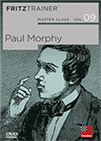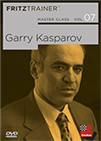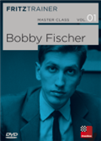Mastering Pattern recognition in the Opening
Do you know when and how to challenge the enemy pawn center? Do you know when to occupy the center with your pawns? How do you know when your opponent makes a random move on the board if that move is good or bad? Are you able to recognize a critical position in the opening? Do you know if to take with a pawn toward the center or if it's better to take toward the side? The answer to these questions and many others is pattern recognition. But how do you acquire such esoteric chess knowledge? Which patterns should you learn? Robert Ris says: studying patterns in openings will help you to learn chess, and become a better player in the process. Any player who studies this DVD will be able to understand the key factors of a position, thanks to a library of patterns skillfully chosen by IM Ris.
Pattern recognition is an important tool in modern chess, as it helps you to understand better the characteristics of a position. Particularly when you have been confronted with a surprise opening system played by your opponent, it helps when you can just
Ris begins the DVD with the well repeated chess mantra: "everything in chess is pattern recognition". So where is the trick one could ask? Well, the problem is definitely not a magical "talent" but memory and the brain. Passion for the game makes a big difference in the amount of hours one spends studying chess, instead of watching the latest flick on Netflix.
Then of course there is the age of the brain. A young player's brain – and today if he is not already a GM at 12, he should consider another career – has not the same level of hormones and neurotransmitters that my old nearly 54 years old brain has. Why is this important? Because with the same amount of training hours, let's say a minimum of 10 hours a week, the younger brain will be able to store more information from short term memory into long term memory.
Then of course we must be open-minded. Some people only want to learn one opening. This will limit the chess understanding they will gain. Since different openings teach the difference of importance of the different pieces, their placement, the different tactics which we are exposed to in different openings.
In the above position we see in practice the meaning behind Ris' words. The rook on a7 can be quite bewildering for someone who doesn't know this opening, but as Ris mentions, this is the right way to defend the pawn on b7.
This DVD is a must for every chess player because the themes treated are important for everyone. Ris has created a theoretical section, in which he gives us the important ideas we will use in our games. And he prepared 50 interactive tests, in which we work on our understanding of the material presented in the theoretical section, learning how to tune and synchronize theoretical knowledge, and how to apply it in practice.
The first section is about the center. Today, we can learn some topics in a very easy manner. Previously, we had to find a book, maybe Nimzowitsch, trying to follow the examples that were explained in an outdated language, by someone who definitely lived in a different century. Now we have a teacher speaking to us, and showing example after example, using a screen and the voice, like in a real lecture in college. Obviously this system, since it involves different senses, could help us in fixing the material in our memory, in a better way than a book.
But why is the pawn center important? In Ris' words the problem is that neglecting the pawn center means to let the opponent gain the initiative. However, Ris doesn't stop there. He gives clear guidelines how to play with a good pawn center and how to play against the pawn center. His guidelines go into the realm of strategy, teaching us how to think during the game, and which sets of ideas can be useful. Yes, a chess game is a battle of ideas, and the player who has more ideas will prevail in the end, or like Capablanca said: will be luckier! Ris shows different example of when White is occupying the center, and how Black can challenge it.
The first example is quite interesting, because Ris shows one of the games of one of his students. In the following position would you play e4-e5 or Nb1-c3?
Ris in the video gives a lengthy explanation showing some lines to prove why one move is better than the other.
 Learn about one of the greatest geniuses in the history of chess! Paul Morphy's career (1837-1884) lasted only a few years and yet he managed to defeat the best chess players of his time.
Learn about one of the greatest geniuses in the history of chess! Paul Morphy's career (1837-1884) lasted only a few years and yet he managed to defeat the best chess players of his time.The second topic, lead in development, is something we can learn also from other sources. The first player who comes to mind is Morphy, and I use his games as example for my students. Ris used material from his own games to explain how to punish someone lacking in development. Kasparov also played some nice games in which he was able to exploit a lead in development to keep the enemy king in the center, but the real beauty of such games is how he managed to transform one advantage into another other, till he won. Here's an example:
 On this DVD a team of experts gets to the bottom of Kasparov's play. In over 8 hours of video running time the authors Rogozenko, Marin, Reeh and Müller cast light on four important aspects of Kasparov's play: opening, strategy, tactics and endgame.
On this DVD a team of experts gets to the bottom of Kasparov's play. In over 8 hours of video running time the authors Rogozenko, Marin, Reeh and Müller cast light on four important aspects of Kasparov's play: opening, strategy, tactics and endgame.Ris explains some of his own games. I found some positions quite interesting. The following is such an example. What would you play with White? In the second video Ris explains it quite well.
Here's another position I found interesting. In this game Ris missed the move Qa3, which would have kept the enemy king in the center.
Here one is asked to find out why Black cannot play Qxb6. How would White continue?
The DVD has videos dedicated to: king in the center, neglecting kingside development, grabbing a poisoned pawn (the game used as example is beautiful because it shows how piece activity is more important than material advantage!).
I also think it's important to have a mental library of games, which one can use to show students what grabbing a poisoned pawn means. One such game is the following, included in one of the best chess books ever written:
 No other World Champion was more infamous both inside and outside the chess world than Bobby Fischer. On this DVD, a team of experts shows you the winning techniques and strategies employed by the 11th World Champion.
No other World Champion was more infamous both inside and outside the chess world than Bobby Fischer. On this DVD, a team of experts shows you the winning techniques and strategies employed by the 11th World Champion.
Grandmaster Dorian Rogozenco delves into Fischer’s openings, and retraces the development of his repertoire. What variations did Fischer play, and what sources did he use to arm himself against the best Soviet players? Mihail Marin explains Fischer’s particular style and his special strategic talent in annotated games against Spassky, Taimanov and other greats. Karsten Müller is not just a leading international endgame expert, but also a true Fischer connoisseur.Ris' videos continue with the following topics: capture toward or away from the center (Ris shows how the chess mind changed through different epochs, showing lines from different openings and the pro and cons of capturing toward the center or toward the side, and how chess fashion models our choices), castling too early, flank attack, misplaced piece, space advantage. These themes are quite important for beginners, because beginners often don't have the chess understanding which should guide them in taking the right decision. However Ris throughout the DVD uses examples from grandmaster games to prove the point, showing that no one is immune from a slip in judgment.

A moment from the video on misplaced pieces)
In relation to the topic of castling too early, I thought it was nice to share a game which was played a while back, in 1988, as it shows many of the ideas discussed in the video. The point is to be active learners. In this game we see how White castled too early, and Black, a top GM at that time, decided to go for the attack with g7-g5.
The meat of this new Chessbase DVD is the practical training. Ris prepared approximately 50 tests...

(Time to practice!)
...with which one can apply the knowledge acquired in the theoretical part.

The last part is the bonus section, which consists of two databases. One contains the games used in the video section, the other contains 50 games in which Ris gives light comments to highlight the theme of the games. These games are really important, because we can connect the dots between the theoretical videos in which Ris detailed the many mistakes, and the homework the games provide. Watching them a lamp will light up in our heads and we say: "Ah yes, this is what he meant..."

Pro and Con: in video number 3, entitled: "King in the center", Ris shows a line based on this position:
Ris says that Black cannot castle on the kingside because of the bishop sacrifice of h7, the so-called "greek gift". But after 11.Bxh7 he analyzes only 11...Kxh7 and then the king goes to g6. Unfortunately he didn't analyze if Black could play 11...Kh8. Since in my short life as chess player, I've been damaged by analysis made by titled players which I didn't check, this time I checked. I discovered castling kingside might be possible, if followed by 11...Kh8. This analysis would justify castling on the kingside.
I let my engine (Komodo 13 latest version, but the computer I'm using is not strong) run for 20 minutes and it confirmed the correctness of the move played in the game. Komodo at depth 37-40 is castling kingside, but the engine doesn't plan to capture the Bh7 and then go to g6. Not happy I used a better computer with Fat Fritz, and also Fat Fritz would castle kingside. Strangely Fat Fritz and Komodo would play the same moves for Black. Here is the game with Ris' analysis, and the one I added from Komodo, feel free to improve my analysis, since in chess we should all aim to discover the truth, and surely someone has a better computer than mine, or a better chess understanding.
However, Ris' advice is sound, one must be careful of possible tactics when there is a bishop on d3, and there is no defender of d7, like a knight on f6.
There are many positives in all of Ris' lectures. For one I felt how he chooses simpler lines over complicated one.
Pattern recognition is an important tool in modern chess, as it helps you to understand better the characteristics of a position. Particularly when you have been confronted with a surprise opening system played by your opponent, it helps when you can just
Final thoughts: I find this material useful also for teaching. Yes, I don't need to re-invent the wheel every time. Ris is a good teacher, I can get his material and use it in my lessons. No time spent for research, no time spent on preparing the lesson, more free time I can spend studying other parts of the game. Obviously, this is true especially if one has mastered and understood the topics taught by Ris before.
In general the DVD is very useful, because thanks to the exercises proposed by Ris we learn to distinguish good and bad moves, and how they should be punished in the opening. This can also improve our own games. Ris' sober analysis of the elements of the position help players of every level to better understand how to evaluate a position, gaining an understanding one can use for one's own tournament chess games. I believe it's worth having it just for gaining more insight into a titled player's mind, since Ris comments extensively on each topic, and the exercises give us an important practice moment. If one is trying to improve in chess, this DVD is a must.
























